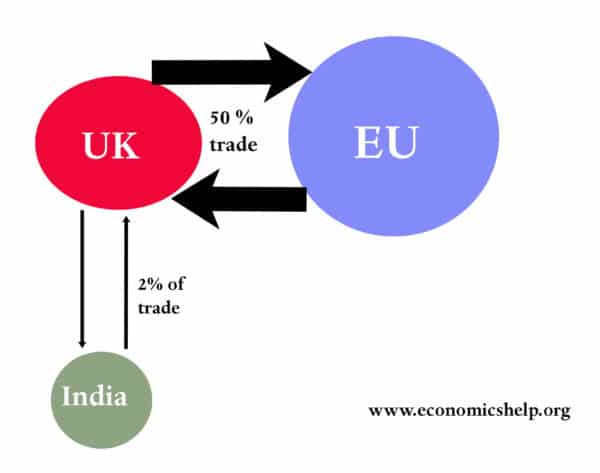New trade theory (NTT) suggests that a critical factor in determining international patterns of trade are the very substantial economies of scale and network effects that can occur in key industries.
These economies of scale and network effects can be so significant that they outweigh the more traditional theory of comparative advantage. In some industries, two countries may have no discernible differences in opportunity cost at a particular point in time. But, if one country specialises in a particular industry then it may gain economies of scale and other network benefits from its specialisation.
Another element of new trade theory is that firms who have the advantage of being an early entrant can become a dominant firm in the market. This is because the first firms gain substantial economies of scale meaning that new firms can’t compete against the incumbent firms. This means that in these global industries with very large economies of scale, there is likely to be limited competition, with the market dominated by early firms who entered, leading to a form of monopolistic competition.
Monopolistic competition is an important element of New Trade Theory, it suggests that firms are often competing on branding, quality and not just simple price. It explains why countries can both export and import designer clothes.
This means that the most lucrative industries are often dominated in capital-intensive countries, who were the first to develop these industries. Therefore, being the first firm to reach industrial maturity gives a very strong competitive advantage. (some may say unfair advantage)
New trade theory also becomes a factor in explaining the growth of globalisation.
It means that poorer, developing economies may struggle to ever develop certain industries because they lag too far behind the economies of scale enjoyed in the developed world. This is not due to any intrinsic comparative advantage, but more the economies of scale the developed firms already have.
Paul Krugman was a leading academic in developing New Trade Theory. He was awarded a Nobel Prize (2008) in economics for his contributions in modelling these ideas. “for his analysis of trade patterns and location of economic activity”.
Examples of New Trade Theory
- Specialisation of IT in Silicon Valley – the US. Hewlett and Packard started their computer business. Success attracted more IT firms to that area. Not because of any particular intrinsic benefit but new firms start to get the network benefits of being around other IT setups.’
- Globalisation has led to increased variety for consumers. The proliferation of brand clothing labels. Firms competing in the model of monopolistic competition and heavy branding. Neither UK or Italy has a particular comparative advantage in producing clothes, but consumers are attracted to brand image of Italian and British fashion labels.
New Trade Theory and Government regulation
New trade theory suggests that governments might have a role to play in promoting new industries and supporting the growth of key industries. Some point to the Japanese car industry in the 1950s, which received substantial government support. Other S.E. Asian economies also had some government protection and support.
A developing economy may need tariff protection and domestic subsidy to encourage the creation of capital-intensive industries. If the industry gets support for a few years, it will be able to exploit economies of scale and then be competitive without government support. This is similar to earlier arguments surrounding infant industries.
Problems of Government intervention
This idea of government supporting new industries is controversial. Many economists say that it is likely to create other problems such as
- The government is likely to have poor information about which industry to support and how to go about it.
- It creates a tendency for powerful vested business interests which rely on state support. This state support may encourage inefficiency in the long-term.
New trade theory and Gravity theory
Gravity theory suggests trade is influenced by countries geographical proximity and similarities in terms of culture and economic development. It suggests neighbouring countries are more likely to trade with each other. Gravity theory is an element of ‘New trade theory’ as it emphasis factors which influence trade – other than traditional ‘comparative advantage’
Conclusion
New trade theory is not primarily about advocating government intervention in industry; it is more a recognition that economies of scale are a key factor in influencing the development of trade. It also suggests that free trade and laissez-faire government intervention may be much less desirable for developing economies who find themselves unable to compete with established multi-nationals.
Related
External Links
- Increasing Returns, monopolistic competition and returns to trade. – A simple, general equilibrium model of non-comparative advantage trade. Trade is driven by economies of scale, which are internal to firms. Because of the scale economies, markets are imperfectly competitive. Nonetheless, one can show that trade, and gains from trade, will occur, even between countries with identical tastes, technology, and factor endowments. Krugman (1979)
- Increasing returns and economic geography – JSTOR


It could be argued that economies of scale and network effects are themselves a form of comparative advantage. E.g. if country X exploits economies of scale in industry Y, it then has comparative advantage in that industry.
“poorer, developing economies may struggle to ever develop certain industries because they lag too far behind the economies of scale…”. That sounds to me like the well known “infant industry” idea which has been around for a very long time.
Yes, I think New trade theory really gives more quantitative backing for former concepts. Krugman acknowledged his debt to less mathematical economists like Ohlin http://www.pkarchive.org/theory/ohlin.html
What was the empirical ndings that led to the development of the new trade theory?
What are the empirically inconsistent elements of the new trade theory that
prompted the development of new trade theory?
What are the sources of gains from trade in \new new trade” theory?
I want know that is there any example of new trade theorym in the real practice.